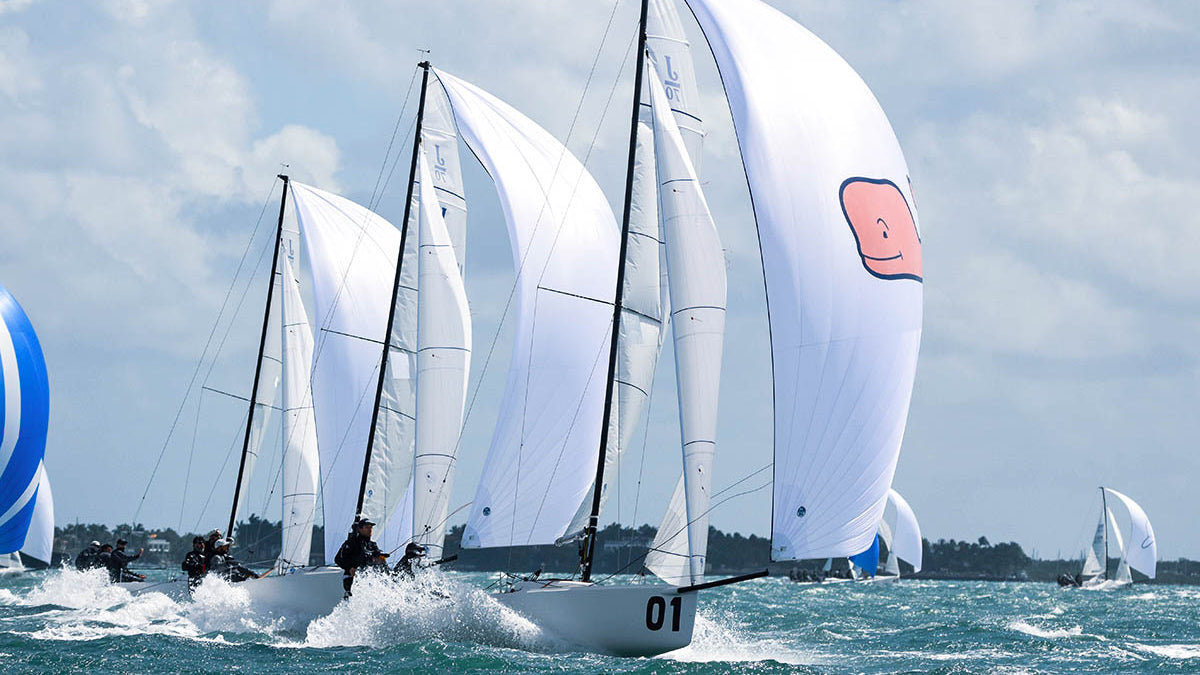J/70 TIPS: HEAVY AIR
J/70 TIPS: HEAVY AIR
Allan Terhune Explains What Worked for Team Vineyard Vines at the 2020 J/70 Midwinters.
When the breeze increases, a different set of skills are required. We caught up with North Sails expert Allan Terhune, who called tactics on the winning team at the J/70 Midwinters in Miami, for some lessons learned from a windy weekend.
Sailing in Breeze – Upwind
The key to speed upwind is keeping the boat flat and balanced. This is achieved two ways: rig tune and trim.
Rig Tune
We were at the top of our tuning guide most of the weekend to keep our headstay tight. One key factor is the backstay gross tune; make it TIGHT. You need to have enough throw to pull backstay on, in order to flatten out the main. Many teams took the slack out of their gross tune but didn’t make it tight. Also I heard many people did not go to the top of the tuning guide. If this was not the weekend to go there, I don’t know what would be!
Trim
Once the rig is tuned, the goal is to keep the helm balanced, and also to be able to burp the main in the puffs to eliminate heel. The key to this is the jib sheet. If you have the sail max in-hauled like you would in lighter conditions, the main would immediately luff in puffs, forcing the bow to go down. To compensate for this, we sailed with less inhaul, and moved the lead forward one hole. This may seem counter-intuitive, but it keeps the leech correct and makes the foot powerful enough to get through the chop. We made sure the leech was close to the middle band on the spreader at all times.
We then played the in-hauler to get through waves and puffs. Our main luffed very few times, and we talked all the time about keeping the boat balanced.
As for mainsail trim, it was easy to over-tighten the outhaul and not have enough power through waves. We found that having max backstay was always faster and having enough vang on made it easy to play the sheet. We tried to NEVER let the main luff or flog. You have to be using both sails to be balanced and fast.
Sailing in Breeze – Downwind
Wow was that fun or what! Seriously though, it was HARD work!
A few things to remember off the wind in big breeze:
- Keep a constant angle of heel. Too much heel and you wipe out, too little and you slow down and bear off too much. You have to keep the apparent wind forward.
- Jib trim is crucial. Molly did a great job of always keeping the jib full, but also knew when to blow it if I lost the kite.
- Jibing: Speed is your friend. The worst thing you can do is bear off and slow down and load the boat up right before a jibe. That is when you wipe out.
- Steer around waves and surf whenever possible. Finding a good rhythm with the trimmer and talking about the angles is the best way to identify the path of least resistance.
- Stay in the puff. We all work so hard upwind to go .1 or .2 knots faster, but if you miss a puff downwind you will be 2-5 knots slower. The tacticians who keep their eyes out for the next puff make HUGE gains.
This regatta was a great reminder that the J/70 is truly a team boat. Everyone has a role, and if one person is not carrying their weight, the boat does not succeed. For success in heavy air, you need to develop a different set of skills. And practicing with your team when it’s windy is the only way to get better.
Team Vineyard Vines John and Molly Baxter, Ben Lamb, and Allan Terhune are the 2020 J/70 Midwinter Champs after a relentless eight-race battle in a variety of testing conditions. On the final day, they snagged two bullets using the 2019 J/70 Worlds winning inventory: F-1 Mainsail, J-6 High Clew Jib and AP-1 Asymmetrical kite. | Full story






























